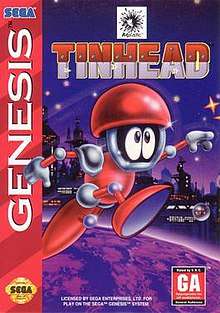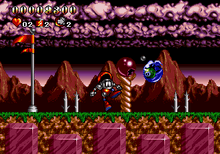Tinhead (video game)
Tinhead is a platform video game developed by Microprose U.K. and published by Ballistic and Spectrum HoloByte for the Sega Genesis.
| Tinhead | |
|---|---|
 Original North American Sega Genesis cover art | |
| Developer(s) | MicroProse UK |
| Publisher(s) | Genesis Original release Relaunch Piko Interactive (Super NES) |
| Producer(s) | Stuart Whyte Harvey Lee |
| Designer(s) | Richard Lemarchand |
| Programmer(s) | Chris Newcombe Jim Gardner Nick Thompson |
| Artist(s) | Allan Holloway John Reitze Mark Wilson |
| Writer(s) | Robert Giedt |
| Composer(s) | Paul Tonge |
| Platform(s) | Sega Genesis, Super Nintendo Entertainment System |
| Release | Genesis Original release Re-release
|
| Genre(s) | Platform |
| Mode(s) | Single-player |
It was designed by Richard Lemarchand, with graphics and animation by Trevor Slater, John Reitze, Mark Wilson, Paul Ayliffe, Theo Pantazi, Allan Holloway and Seth Walker, programming by Jim Gardner, Nick Thompson, Paul Dunning and Chris Newcombe, and production by Stuart Whyte.[2]
Plot

An evil intergalactic goblin named Grim Squidge steals all the stars from the sky with a vacuum cleaner-nosed spaceship, seals them in glass spheres and scatters them far and wide across distant planets, threatening the very infrastructure of spacetime.
On a space station far out in the distant reaches of galactic space, Tinhead, the metallic Guardian of the Edge of the Universe, picks up a distress signal from an unknown friend of the stars. Arming his head-mounted ball bearing gun, he rushes to the stars' rescue.
Release
Ports for both the Amiga and Super Nintendo Entertainment System were in development and scheduled for 1994 but were cancelled.[3] Former MicroProse UK employee Steve Goss stated in a 2001 forum post at AtariAge that a conversion of the game was also in development and completed for the Atari Jaguar but was never released due to low sales of the system.[4][5][6]
Reception
Electronic Gaming Monthly gave the game a 6.4 out of 10, commenting that the game is on the hard side but gets by due to useful power-ups and "dynamic" bosses. They cited the graphics as the highlight of the game.[7]
References
- "Tinhead". IGN. Archived from the original on 2018-09-23. Retrieved 2018-09-24.
- "TinHead (1993) Genesis credits". MobyGames. 2006-01-22. Archived from the original on 2014-08-10. Retrieved 2013-02-12.
- G., Evan (2009-11-18). "Tinhead". Snes Central. Archived from the original on 2012-05-24. Retrieved 2013-02-12.
- J., Steve (1993). "Gossip - Lies, Rumours and Just Plain Half Truths". Atari Entertainment. No. 1. The Hide-Out. p. 12.
- Goss, Steve (October 27, 2001). "how hard is it to make jag games???". AtariAge. Archived from the original on 3 April 2018. Retrieved 2018-09-22.
- mmbe (October 13, 2008). "Whatever happened to Gunship 2000?". AtariAge. Archived from the original on 22 September 2018. Retrieved 2018-09-22.
- "Review Crew: Tinhead". Electronic Gaming Monthly (60). EGM Media, LLC. July 1994. p. 38.